Quick answer
Key takeaways
- Sales territory optimization helps businesses maximize revenue and efficiency, balance workloads, and ensure fair distribution across sales teams.
- To optimize sales territories, you need to set clear goals, use workload indexes, analyze future potential, visualize your data, leverage quality mapping software, minimize disruption during changes, and continuously measure and iterate.
- Sales territory optimization supports multi-level delegation and performance tracking and allows you to adjust territories dynamically to reflect market changes.
The advantages of sales territory optimization are undeniable. Effective sales territory management is key to maximizing revenue, reducing costs, and improving productivity. By understanding the importance of sales territory management and strategically aligning sales resources with customer needs, businesses can ensure balanced workloads, minimize inefficiencies, and drive growth.
Modern mapping and optimization software empowers you as a sales leader to design data-driven territories, uncover hidden insights, and make smarter decisions.
Why Territory Optimization Matters
Sales managers are all too familiar with the challenge of maximizing revenue with limited resources. It is complex and dynamic, and good sales territory management is critical to achieving those goals.
With the right business mapping software, you can easily optimize your sales territories and gain invaluable insights that help you improve efficiency and make better decisions. Here, we'll discuss the competitive advantages of sales territory alignment and guide you through the optimization process.
Step-by-step Guide to Building
Optimized Sales Territories
Optimizing your sales territories is easier than you think, especially with support from the right tools. Here’s how to do it.
Step 1
Set Clear Alignment Goals
Start by setting clear objectives. What's behind your need for territory management? Are you focused on maximizing revenue, improving customer coverage, reducing travel time, or balancing workloads across teams?
Establishing these objectives early ensures that the territory design:
- Aligns with your company's priorities, and
- Provides a measurable framework for success
Clear goals also help you gain stakeholder buy-in and set expectations for your sales team.
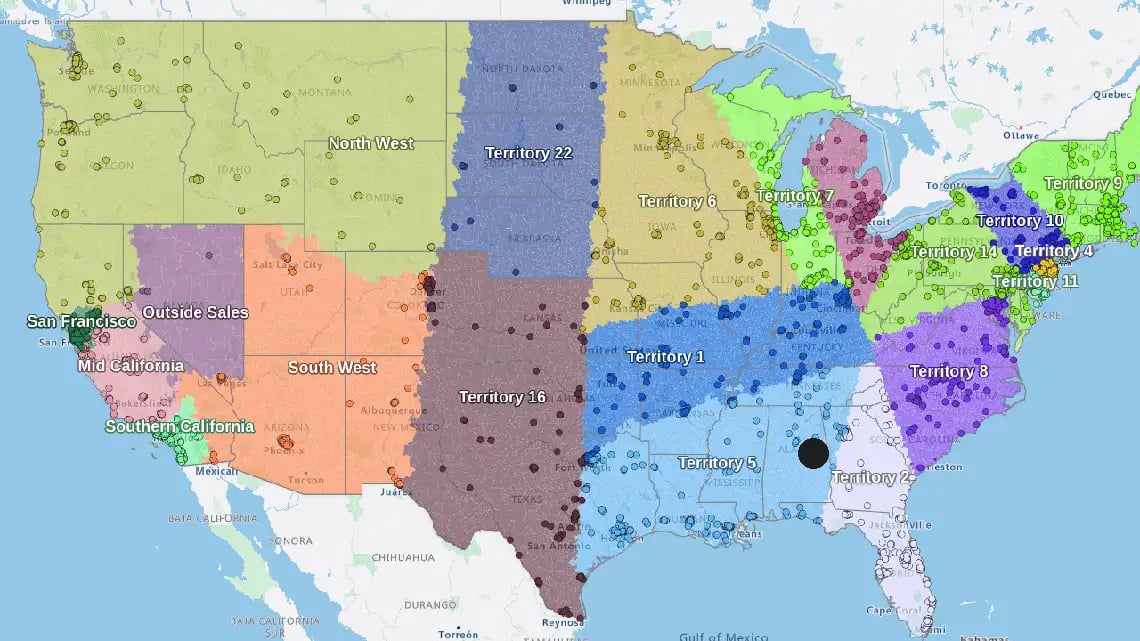
Step 2
Use Workload Indexes to Balance Territories
Assess factors like account size and travel time to create balanced workloads across your sales reps. A workload index prevents rep burnout in high-demand territories while ensuring that underperforming regions receive adequate attention. This leads to fairer workload distribution and higher productivity.
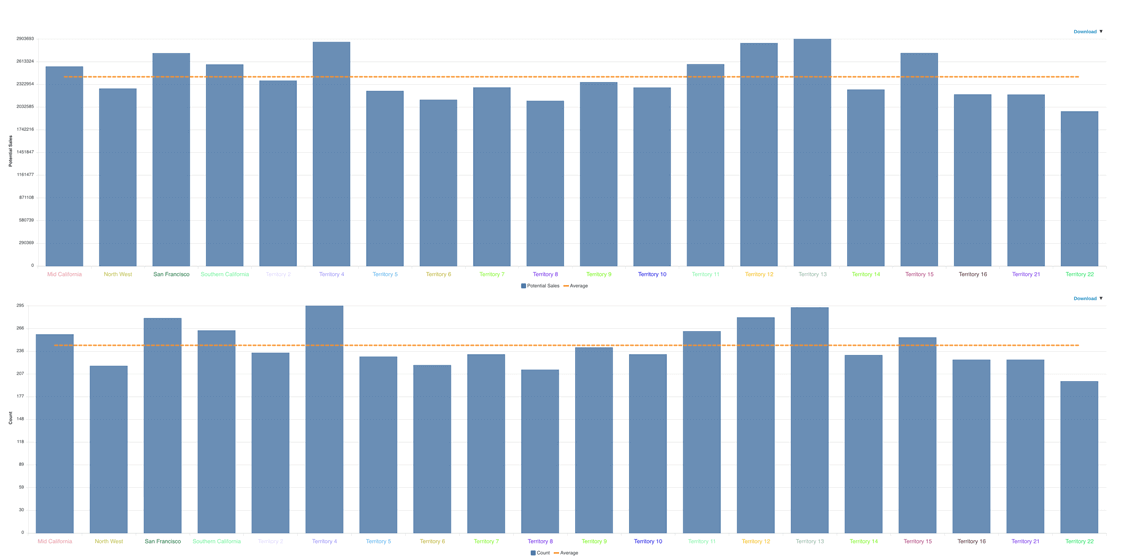
To get the most from your territory mapping strategy, include route optimization capabilities. An ideal blend for a mapping platform for sales and operations is a solution that includes advanced mapping, territory optimization, and route optimization. All should work seamlessly together.
Step 3
Analyze Sales Potential, Not Just Past Performance
While historical sales data is valuable, relying solely on past performance can lead to missed opportunities. Look to the future and use predictive analytics to assess untapped potential and upcoming trends in different regions, industries, or customer segments. This forward-looking approach drives smarter resource allocation.
Step 4
Visualize Your Data to Uncover Insights
Data visualization tools, like heat maps or pin maps, transform complex datasets into intuitive interactive maps and dashboards, making it easier to see trends, gaps, and opportunities. This enables faster, more informed decision-making when adjusting territory boundaries. Visual analysis also makes it easy for stakeholders to understand the rationale behind your decisions.
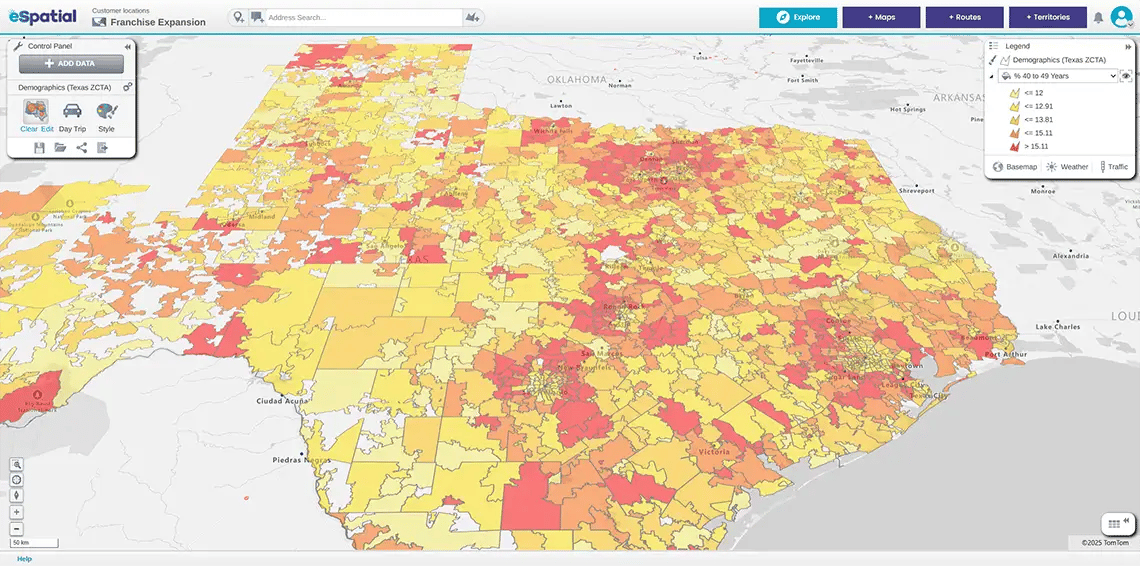
Step 5
Leverage Technology for Smarter, Faster Territory Design
Manual territory planning is time-consuming and can be prone to bias. Advanced sales territory management tools help you optimize boundaries based on real-time data, ensuring fairness and efficiency. Using sales optimization software, you can design territories with precision and adapt quickly to evolving business needs.
Use territory management software like eSpatial to reduce the administrative load and remove guesswork. eSpatial’s sophisticated algorithms deliver balanced results in minutes.
Step 6
Plan for Minimal Disruption
Territory changes can disrupt customer relationships and impact sales team morale, so ensure that it doesn’t interfere with your sales territory optimization benefits.
Approach any changes with care:
- Implement adjustments gradually
- Communicate clearly with sales teams
- Avoid frequent overhauls, so you can maintain stability while still improving efficiency
Step 7
Measure Impact and Iterate
Optimizing sales territories is an ongoing process. After implementation, track key metrics such as revenue growth, rep productivity, and customer satisfaction to assess effectiveness. Gather feedback from the sales team to identify pain points and opportunities for improvement.
Continuous iteration based on reliable data and real-world performance ensures that your territories remain aligned with your business goals and market dynamics over time.
Learn more about how to grow a territory.
Advanced Benefits of Sales
Territory Optimization
Benefit 1
Hierarchical Structures
Sales territory hierarchies are a norm in most organizations, allowing sales operations and managers to balance the sales structure better. They are great for collaboration and delegation, as well as regional performance analysis. As one of its key sales territory optimization benefits, eSpatial allows up to six levels of hierarchy, which means you can build your sales structure from sales territories up. Easily move up or down a level to assess your KPIs for each team.

It is an essential tool for managing delegation, for example, ensuring that each sales manager is responsible for 10 sales reps or each regional manager is responsible for eight sales managers. You have complete control over the sales structure, making it easy to ensure balance and fairness.
Benefit 2
Collaboration and Sharing
All teams benefit from greater levels of collaboration and sharing. Sales territory mapping software is the perfect tool to share territory designs and alignments.
When realigning or creating new territories, you can share them as a map with those affected and get instant feedback. It boosts engagement and allows vital input from those in the field. Technology may be amazing, but it cannot replace human experience and real-world know-how. Sharing boosts engagement and speeds up your design process.
It also makes your HR team happy, as you can easily share data on territory changes and how they impact quota calculations.
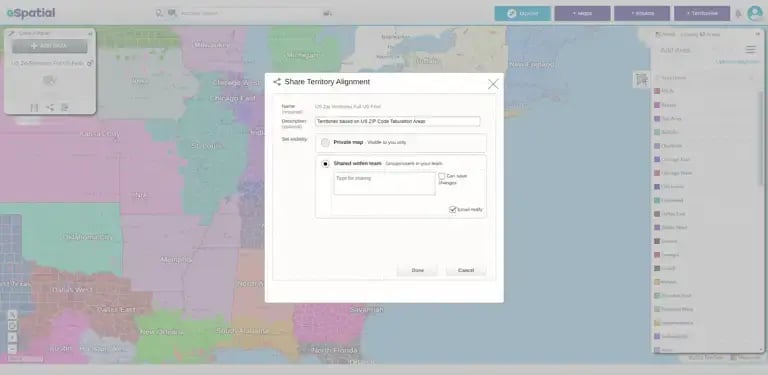
Benefit 3
Reporting and Analytics
Sales optimization software like eSpatial provides reporting and analytics capabilities, allowing you to track performance metrics. You’ll get actionable insights into sales trends, customer behavior, and team productivity.
Customizable dashboards and automated reports help identify strengths, weaknesses, and opportunities, so you can make data-driven decisions that boost efficiency and drive revenue growth.
Use advanced mapping and analytics software to get the most out of your reports.
Benefit 4
Scenario Modeling
Sales optimization software enables you to forecast outcomes based on different strategies and market conditions. By simulating various sales approaches, such as pricing changes, resource allocation, or new market entry, you can assess potential risks and rewards before implementation. This predictive capability helps optimize decision-making, ensuring that your sales strategies are aligned with the company’s objectives.
eSpatial lets you visualize and compare your scenarios to see how your proposed changes could impact revenue, workload, and balance in real time.
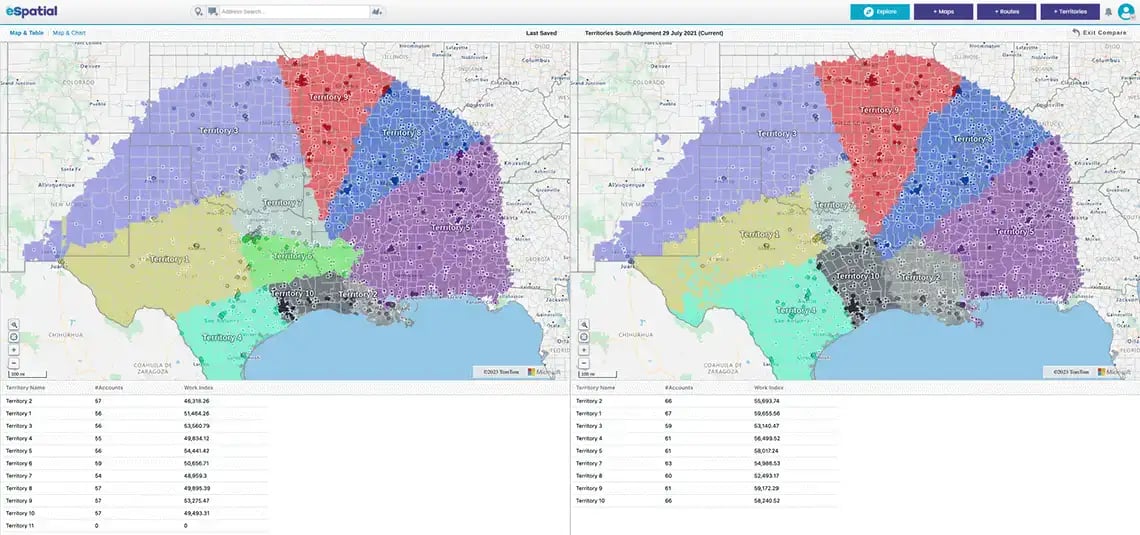
View the pricing plans for eSpatial.
Conclusion: A New Revenue Engine Awaits
Transform your sales performance with a smarter, data-driven territory strategy. Use a sophisticated territory mapping tool to boost sales productivity, reduce territory design and re-alignment time, and transform the way your team collaborates.

